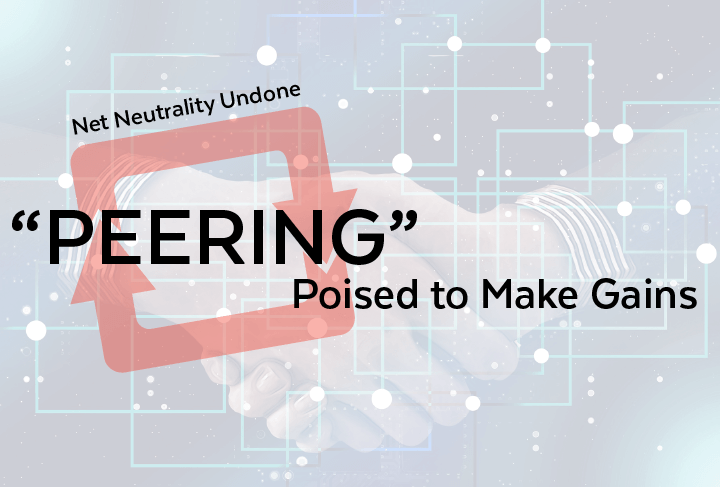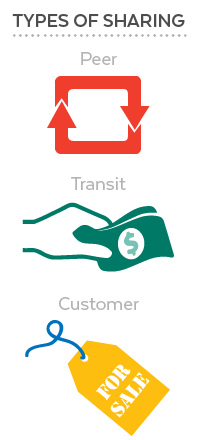On Thursday, December 14, the U.S. Federal Communications Commission (FCC) repealed its 2015 network neutrality rules which will greatly impact peering. We wrote an article about this very topic a few weeks ago, but let’s do a quick recap.
Net neutrality rules required ISPs to treat all online content equally. The ruling was instituted to bar the preferential treatment of one website [business] over another.
The repeal effort while, strongly supported by providers like Comcast and Verizon, has also felt intense criticism by others within the internet industry. Many view it as a threat to a fair and open internet for all.
The highly partisan and at times violent debate has by-and-large failed to expose that Netflix and YouTube do pay ISPs for bandwidth, while many smaller operators don’t. Reuters quoted one anonymous former video streaming executive, as saying, “From the era of having no net neutrality to the era of having it, nothing changed.”
Whether you choose to accept that statement at face value or not, fears continue to mount among smaller companies and sole proprietors. Fears that they’ll soon suffer repercussions including loss of business and bandwidth due to preferential treatment of companies with fatter wallets.
The horizon, happily, may not be as cloudy as it seems. Net neutrality could still sway one way or the other in the coming months and years. But there’s another practice, that’s been successfully employed for years that could take much of the concern out of the problem. I’m thinking specifically of bandwidth sharing, or “peering”.
Today we’ll do a deep dive on peering. We’re trusting that you’ll emerge from this reading a bit more hopeful about the outcomes from the recent FCC repeal of net neutrality.
What is Peering?
So what exactly is peering?
Wikipedia calls it the voluntary interconnection of administratively separate Internet networks for the purpose of exchanging traffic between the users of each network.
There are 2 other types of bandwidth sharing that are worth noting:
- Transit sharing involves payment for access to another company’s bandwidth.
- Customer sharing involves selling of your company’s extra bandwidth to another.
Neither of these types of sharing count as “peering,” mind you. Peering is a swapping relationship.
These agreements tend to be settlement free. What that means is that neither party pays the other in the agreement for the exchange of traffic. Each party derives and retains revenue from its own customers.
What? No overage fees? You heard that right.
I’m sure this is already sounding good to readers. It’s an easy sell to company controllers after all.
When you know that you’ll only pay a small set up fee in order to access greater bandwidth capacity, life is good. Of course there’s also the legal review of an agreement between parties, but that hardly constitutes an obstacle.
Types of Peering
There are essentially 2 types of peering: public and private. There are good reasons for both to be well-used and understood. Let’s take a look.
Public peering
This type of peering is performed across a shared network at the Internet Exchange. Public peering is perfect for companies whose bandwidth needs are big, and are willing to spread their “take” across a bunch of other companies to get as much as they can.
Netflix is a prime example of the type of business that can strongly benefit from public peering.
Private peering
This type of peering takes place privately between members of a data center or private cloud customer community. When privacy or financial security is a top priority, then this is the way to go.
How to Join a Peering Exchange
So let’s say you’re curious to learn more, and you want to give peering a shot. What do you do next?
For starters, establish contact with an exchange through your data center provider.
You can also route into an exchange such as the NYIIX or the LAIIX. You can use this interactive map to access a full list of exchange points to find one that meets your need in terms of location.
You’ll need an interconnecting device such as a router and an Ethernet switch for public peering. For private you’ll definitely need to route through a data center or cloud provider.
What If Peering Isn’t For You
Peering is not the answer to every problem that Internet denizens may face. It’s just one (potentially powerful) way to get more bandwidth and speed up your business bandwidth access.
But let’s say it’s not a good solution for you. You may be wondering what’s in store for the US public in terms of Internet regulation.
Each side is still shouting rather loudly, so your guess is probably as good as ours.
Senator Chuck Schumer, reported Ars Technica on December 18th, was quoted saying “There will be a [Senate] vote to reinstate net neutrality.”
Meanwhile Motherboard reports that Comcast is pushing for a “flimsy” law it knows Telecom Lobbyists will be more than happy to promote to their favorite congressmen and women.
The debate rages on. We’ll just have to buckle up and stay updated as events unfold.
The Future Isn’t All Doom and Gloom
If we’re being fair, there have been conflicts like this before.
Netflix and Comcast went-to-the-mats over a major escalation in video streaming. Netflix ended up paying Comcast for bandwidth despite the accusation that (according to Reuters) it was “double dipping” by also receiving money from home internet subscribers.
This is not an isolated incident. Youtube faced similar accusations.
Small companies and solopreneurs don’t have deep pockets like the big guys, so there’s a real threat in a post net-neutrality internet. But time will tell if these fears come to fruition.
The good news is, the FTC is back in the picture. Maybe having that “extra set of eyes” will help make sure issues get handled fairly, and that consumers don’t end up worse for wear.
For more information on net neutrality, be sure to check out this article from PLANET’s sister site.



